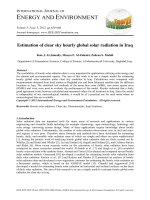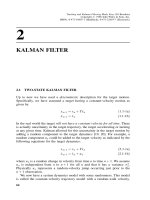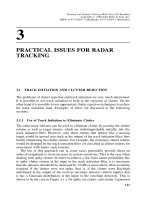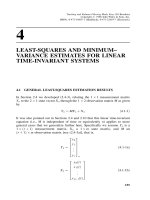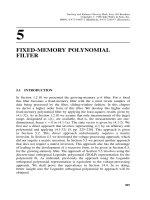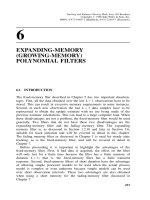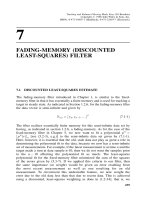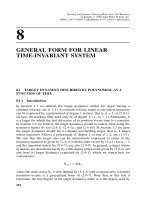- Trang chủ >>
- Khoa Học Tự Nhiên >>
- Vật lý
Crystallography made crystal clear
Bạn đang xem bản rút gọn của tài liệu. Xem và tải ngay bản đầy đủ của tài liệu tại đây (5.87 MB, 305 trang )
Crystallograph
Mad
Crystal Clear:
Model
Second Edjtion
Gale Rhodes
Department of Chemistry
University of Southern Maine
Portland, Maine
CMCC Home Page: www.usm. maine.edu/-rhodes/CMCC
ACADEMIC PRESS
San Diego
San Francisco
New York Boston
London
Sydney
Tokyo
This book is printed on acid-free paper.
@
Copyright 02000, 1993 Elsevier Science (USA).
All Rights Reserved.
No part of this publication may be reproduced or transmitted in any form or by any
means, electronic or mechanical, including photocopy, recording, or any information
storage and retrieval system, without permission in writing from the publisher.
Requests for permission to make copies of any part of the work should be mailed to:
Permissions Department, Academic Press, 6277 Sea Harbor Drive,
Orlando, Florida 32887-6777
Academic Press
An imprint of Elsevier Science
525 B Street, Suite 1900, San Diego, California 92101-4495, USA
http:Nwww.academicpress.com
Academic Press
84 Theobalds Road, London WClX 8RR, UK
n
Library of Congress Catalog Card Number: 99-63088
International Standard Book Number: 0-12-587072-8
PRINTED IN THE UNITED STATES OF AMERICA
03 04 05 06 07
9 8 7 6 5 4 3
Like everything, for Pam.
Contents
Preface to the Second Edition
Preface to the First Edition
1. Model and Molecule
...
xm
xvii
I
2. An Overview of Protein Crystallography
I. Introduction
5
A. Obtaining an image of a microscopic object
7
B. Obtaining images of molecules
C. A thumbnail sketch of protein crystallography
11. Crystals
8
8
A. The nature of crystals
B. Growing crystals
9
III. Collecting X-ray data
10
12
IV. Diffraction
A. Simple objects
12
B. Arrays of simple objects: Real and reciprocal lattices
C. Intensities of reflections
14
15
D. Arrays of complex objects
E. Thee-dimensional arrays
16
17
V. Coordinate systems in crystallography
VI. The mathematics of crystallography: A brief description
19
A. Wave equations: Periodic functions
20
B. Complicated periodic functions: Fourier series
13
19
U. Electron-density maps
24
E. Electron density from structure factors
25
F. Electron density from measured reflections
27
28
G. Obtaining a model
3. Protein Crystals
29
I. Properties of protein crystals
29
A. Introduction
29
B. Size, structural integrity, and mosaicity
29
C. Multiple crystalline forms
31
D.Watercontent
32
11. Evidence that solution and crystal structures are similar
A. Proteins retain their function in the crystal
33
B. X-ray structures are compatible with other structural
evidence
34
C. Other evidence
34
III. Growing protein crystals
35
A. Introduction
35
B. Growing crystals: Basic procedure
35
C. Growing derivative crystals
37
D. Finding optimal conditions for crystal growth
37
IV. Judging crystal quality
41
V. Mounting crystals for data collection
43
4. Collecting Diffraction Data
33
45
I. Introduction
45
11. Geometric principles of diffraction
45
A. The generalized unit cell
46
B. Indices of the atomic planes in a crystal
47
C. Conditions that produce diffraction: Bragg's law
D. The reciprocal lattice
52
E. Bragg s law in reciprocal space
55
F. The number of measurable reflections
58
G. Unit-cell dimensions
60
H. Unit-cell symmetry
60
III. Collecting X-ray difYraction data
64
7
50
Contents
A. Introduction
64
B. X-ray sources
65
C. Detectors
69
D. Diffractometers and cameras
72
E. Scaling and postrefinement of intensity data
F. Determining unit-cell dimensions
80
G. Symmetry and the strategy of collecting data
IV. Summary
83
5. From Diffraction Data to Electron Density
I. Introduction
85
11. Fourier series and the Fourier transform
86
A. One-dimensional waves
86
B. Three-dimensional waves
88
C. The Fourier transform: General features
90
D. Fourier this and Fourier that: Review
92
111. Fourier mathematics and diffraction
92
A. Stucture factor as a Fourier series
92
B. Electron density as a Fourier series 94
C. Computing electron density from data
95
D. The phase problem
95
IV. The meaning of the Fourier equations
95
A. Reflections as Fourier terms: Equation (5.18)
B. Computing structure factors from a model:
96
Equations (5.15) and (5.16)
C. Systematic absences in the diffraction pattern:
Equation (5.15)
98
V. Summary: From data to density
100
6. Obtaining Phases
1
95
101
I. Introduction
101
TI. Two-dimensional representation of structure factors
102
A. Complex numbers in two dimensions
102
B. Structure factors as complex vectors
103
C. Electron density as a function of intensities and phases
106
111. The heavy-atom method (isornorphous replacement)
107
A. Preparing heavy-atom derivatives
108
L.
~ U ~ U L I I I ~ IIC-uvy
U L U ~ ~ 1
~1J
1 LII~
U ~ ~ LLL~ I I
11-r
IV. Anomalous scattering
118
118
A. lntroduction
119
B. The measurable effects of anomalous scattering
120
C. Extracting phases from anomalous scattering data
D. Summary
123
124
E. Multiwavelength anomalous diffraction phasing
F. Anomalous scattering and the hand problem
125
G. Direct phasing: Application of methods from small-molecule
crystallography
126
127
V. Molecular replacement: Related proteins as phasing models
A. Introduction
127
B. Isomorphous phasing models
128
129
C. Nonisomorphous phasing models
129
D. Separate searches for orientation and location
E. Monitoring the search
130
F. Summary
131
VI. Iterative improvement of phases (preview of Chapter 7)
7. Obtaining and Judging the Molecular Model
I. Introduction
133
11. Iterative improvement of maps and models: Overview
111. First maps
137
A. Resources for the first map
137
B. Displaying and examining the map
138
C. Improving the map
139
IV. The model becomes molecular
141
A. New phases from the molecular model
141
B. Minimizing bias from the model
142
C.Mapfitting
144
V. Structure refinement
146
A. Least-squares methods
146
B. Crystallographic refinement
147
C. Additional refinement parameters
147
149
D. Local minima and radius of convergence
150
E. Molecular energy and motion in refinement
VI. Convergence to a final structure
151
151
A. Producing the final map and model
Contents
B. Guides to convergence
VII. Sharing the model
154
153
8. A User's Guide to Crystallographic Models
159
I. Introduction
159
11. Judging the quality and usefulness of the refined model
A. Structural parameters
160
162
B. Resolution and precision of atomic positions
C. Vibration and disorder
164
166
D. Other limitations of crystallographic models
E. Summary
169
170
111. Reading a crystallography paper
A. Introduction
170
B. Annotated excerpts of the preliminary (8191) paper
C. Annotated excerpts from the full structure
determination (4192) paper
175
186
IV. Summary
9. Other Diffraction Methods
160
170
187
I. Introduction
187
11. Fiber diffraction
188
196
111. Diffraction by amorphous materials (scattering)
IV. Neutron diffraction
200
V. Electron diffraction
205
209
VI. Laue diffraction and time-resolved crystallography
VII. Conclusion
213
10. Other Kinds of Macromolecular Models
I. Introduction
215
11. NMR models
216
A. Introduction
216
B. Principles
217
C. Assigning resonances
230
D. Determining conformation
232
E. PDB files for NMR models
235
215
111. Homology models
237
A. Introduction
237
B. Principles
238
C. Databases of homology models
D. Judging model quality
243
IV. Other theoretical models
246
242
11. Tools for Studying Macromolecules
247
I. Introduction
247
11. Computer models of molecules
248
248
A. Two-dimensional images from coordinates
249
B. Into three dimensions: Basic modeling operations
C. Three-dimensional display and perception
250
251
D. Types of graphical models
252
111. Touring a typical molecular modeling program
253
A. Importing and exporting coordinates files
B. Loading and saving models
253
C. Viewing models
254
255
D. Editing and labeling the display
E. Coloring
256
F. Measuring
257
G. Exploring structural change
257
258
H. Exploring the molecular surface
I. Exploring intermolecular interactions: Multiple models
J. Displaying crystal packing
260
K. Building models from scratch
260
IV. Other tools for studying structure
261
A. Tools for structure analysis
261
263
B. Tools for modeling protein action
V. A final note
263
Index
265
259
Preface to the Second Edition
The first edition of this book was hardly off the press before I was kicking
myself for missing some good bets on how to make the book more helpful to
more people. I am thankful that heartening acceptance and wide use of the first
edition gave me another crack at it, even before much of the material started to
show its age. In this new edition, I have updated the first eight chapters in a
few spots and cleaned up a few mistakes, but otherwise those chapters, the soul
of this book's argument, are little changed. I have expanded and modernized
the last chapter, on viewing and studying models with computers, bringing it
up to date (but only fleetingly, I am sure) with the cyber-world to which most
users of macromolecular models now turn to pursue their interests and with
today's desktop computers-sleek, friendly, cheap, and eminently worthy
successors to the five-figure workstations of the eighties.
My main goal, as outlined in the Preface to the First Edition, which appears
herein, is the same as before: to help you see the logical thread that connects
those mysterious diffraction patterns to the lovely molecular models you can
display and play with on your personal computer. An equally important aim is
to inform you that not all crystallographic models are perfect and that cartoon
models do not exhaust the usefulness of crystallographic analysis. Often there
is both less and more than meets the eye in a crystallographic model.
So what is new here? Two chapters are entirely new. The first one is "Other
Diffraction Methods." In this chapter (the one I should have thought of the
first time), I use your new-found understanding of X-ray crystallography to
build an overview of other techniques in which diffraction gives structural
clues. These methods include scattering of light, X rays, and neutrons by powders and solutions; diffraction by fibers; crystallography using neutrons and
electrons; and time-resolved crystallography using many X-ray wavelengths
at the same time. These methods sound forbidding, but their underlying
xiii
X~V
Preface to the Second Edition
principles are precisely the same as those that make the foundation of singlecrystal X-ray crystallography.
The need for the second new chapter, "Other Types of Models," was much
less obvious in 1992, when crystallography still produced most of the new
macromolecular models. This chapter acknowledges the proliferation of such
models from methods other than diffraction, particularly NMR spectroscopy
and homology modeling. Databases of homology models now dwarf the Protein Data Bank, where all publicly available crystallographic and NMR models are housed. Nuclear magnetic resonance has been applied to larger
molecules each year, with further expansion just a matter of time. Users must
judge the quality of all macromolecular models, and that task is very different
for different kinds of models. By analogies with similar aids for crystallographic models, I provide guidance in quality control, with the hope of making you a prudent user of models from all sources.
Neither of the new chapters contains full or rigorous treatments of these
"other" methods. My aim is simply to give you a useful feeling for these methods, for the relationship between data and structures, and for the pitfalls inherent in taking any model too literally.
By the way, some crystallographers and NMR spectroscopists have argued
for using the term structure to refer to the results of experimental methods,
such as X-ray crystallography and NMR, and the term model for theoretical
models such as homology models. To me, molecular structure is a book forever closed to our direct view, and thus never completely knowable. Consequently, I am much more comfortable with the term model for all of the results
of attempts to know molecular structure. I sometimes refer loosely to a model
as a structure and to the process of constructing and refining models as structure determination, but in the end, no matter what the method, we are trying to
construct models that agree with, and explain, what we know from experiments
that are quite different from actually looking at structure. So in my view, models, experimental or theoretical (an imprecise distinction itself), represent the
best we can do in our diverse efforts to know molecular structure.
Many thanks to Nicolas Guex for giving to me and to the world a glorious
free tool for studying proteins-SwissPdbViewer-along with plenty of support and encouragement for bringing macromolecular modeling to my undergraduate biochemistry students; for his efforts to educate me about homology
modeling; for thoughtfully reviewing the sections on homology modeling;
and for the occasional box of liqueur-loaded Swiss chocolates (whoa!).
Thanks to Kevin Cowtan, who allowed me to adapt some of the clever ideas
from his Book of Fourier to my own uses and who patiently computed image
after image as I slowly iterated toward the final product. Thanks to Angela
Gronenborn, Duncan McRee, and John Ricci for thorough, thoughtful, and
Preface to the Second Edition
XV
helpful reviews of the manuscript. Thanks to Jonathan Cooper and Martha
Teeter, who found and reported subtle and interesting errors lurking within
figures in the first edition. Thanks to all those who provided figures-you are
acknowledged alongside the fruits of your labors. Thanks to Emelyn Eldredge
at Academic Press for inducing me to tiptoe once more through the minefields
of Microsoft Word to update this little volume, and to Joanna Dinsmore for a
smooth trip through production. Last and most, thanks to Pam for generous
support, unflagging encouragement, and amused tolerance for over a third of
a century. Time certainly does fly when we're having fun.
Gale Rhodes
Portland, Maine
March 1999
Preface to the First Edition
Most texts that treat biochemistry or proteins contain a brief section or chapter on
protein crystallography. Even the best of such sections are usually mystifyingfar too abbreviated to give any real understanding. In a few pages, the writer
can accomplish little more than telling you to have faith in the method. At the
other extreme are many useful treatises for the would-be, novice, or experienced
crystallographer. Such accounts contain all the theoretical and experimental
details that practitioners must master, and for this reason, they are quite
intimidating to the noncrystallographer. This book lies in the vast and heretofore
empty region between brief textbook sections on crystallography and complete
treatments of the method aimed at the professional crystallographer. I hope there
is just enough here to help the noncrystallographer understand where crystallographic models come from, how to judge their quality, and how to glean
additional information that is not depicted in the model but is available from the
crystallographic study that produced the model.
This book should be useful to protein researchers in all areas; to students of
biochemistry in general and of macromolecules in particular; to teachers as an
auxiliary text for courses in biochemistry, biophysical methods, and macromolecules; and to anyone who wants an intellectually satisfying understanding
of how crystallographers obtain models of protein structure. This understanding is essential for intelligent use of crystallographic models, whether that use
is studying molecular action and interaction, trying to unlock the secrets of
protein folding, exploring the possibilities of engineering new protein functions, or interpreting the results of chemical, kinetic, thermodynamic, or spectroscopic experiments on proteins. Indeed, if you use protein models without
knowing how they were obtained, you may be treading on hazardous ground.
For instance, you may fail to use available information that would give you
greater insight into the molecule and its action. Or worse, you may devise and
xvii
xviii
Preface to the First Edition
publish a detailed molecular explanation based on a structural feature that is
quite uncertain. Fuller understanding of the strengths and limitations of crystallographic models will enable you to use them wisely and effectively.
If you are part of my intended audience, I do not believe you need to know,
or are likely to care about, all the gory details of crystallographic methods and
all the esoterica of crystallographic theory. I present just enough about methods to give you a feeling for the experiments that produce crystallographic
data. I present somewhat more theory, because it underpins an understanding
of the nature of a crystallographic model. I want to help you follow a logical
thread that begins with diffraction data and ends with a colorful picture of a
protein model on the screen of a graphics computer. The novice crystallographer, or the student pondering a career in crystallography, may find this book a
good place to start, a means of seeing if the subject remains interesting under
closer scrutiny. But these readers will need to consult more extensive works for
fine details of theory and method. I hope that reading this book makes those
texts more accessible. I assume that you are familiar with protein structure, at
least at the level presented in an introductory biochemistry text.
I wish I could teach you about crystallography without using mathematics,
simply because so many readers are apt to throw in the towel upon turning the
page and finding themselves confronted with equations. Alas (or hurrah, depending on your mathematical bent), the real beauty of crystallography lies in
the mathematical and geometric relationships between diffraction data and molecular images. I attempt to resolve this dilemma by presenting no more math
than is essential and taking the time to explain in words what the equations
imply. Where possible, I emphasize geometric explanations over equations.
If you turn casually to the middle of this book, you will see some forbidding
mathematical formulas. Let me assure you that I move to those bushy statement step by step from nearby clearings, making minimum assumptions about
your facility and experience with math. For example, when I introduce periodic functions, I tell you how the simplest of such functions (sines and cosines)
"work," and then I move slowly from that clear trailhead into the thicker forest
of complicated wave equations that describe X rays and the molecules that diffract them. When I first use complex numbers, I define them and illustrate their
simplest uses and representations, sort of like breaking out camping gear in the
dry safety of a garage. Then I move out into real weather and set up a working
camp, showing how the geometry of complex numbers reveals essential information otherwise hidden in the data. My goal is to help you see the relationships implied by the mathematics, not to make you a calculating athlete. My
ultimate aim is to prove to you that the structure of molecules really does lie
lurking in the crystallographic data-that, in fact, the information in the diffraction pattern implies a unique structure. I hope thereby to remove the mystery about how structures are coaxed from data.
Preface to t h e First Edition
xix
If, in spite of these efforts, you find yourself flagging in the most technical chapters (4 and 7), please do not quit. I believe you can follow the arguments of these
chapters, and thus be ready for the take-home lessons of Chapters 8 and 11, even
if the equations do not speak clearly to you. Jacob Bronowski once described the
verbal argument in mathematical writing as analogous to melody in music, and
thus a source of satisfaction in itself. He likened the equations to musical accompaniment that becomes more satisfying with repeated listening. If you follow and
retain the melody of arguments and illustrations in Chapters 4 through 7, then the
last chapters and their take-home lessons should be useful to you.
I aim further to enable you to read primary journal articles that announce and
present new protein structures, including the arcane sections on experimental
methods. In most scientific papers, experimental sections are directed primarily
toward those who might use the same methods. In crystallographic papers, however, methods sections contain information from which the quality of the model
can be roughly judged. This judgement should affect your decision about whether
to obtain the model and use it, and whether it is good enough to serve as a guide
in drawing the kinds of conclusions you hope to draw. In Chapter 8, to review
many concepts, as well as to exercise your new skills, I look at and interpret
experimental details in literature reports of a recent structure determination.
Finally, I hope you read this book for pleasure-the sheer pleasure of turning
the formerly incomprehensible into the familiar. In a sense, T am attempting
to share with you my own pleasure of the past ten years, after my mid-career
decision to set aside other interests and finally see how crystallographers produce the molecular models that have been the greatest delight of my teaching.
Among those I should thank for opening their labs and giving their time to a n
old dog trying to learn new tricks are Professors Leonard J. Banaszak, Jens
Birktoft, Jeffry Bolin, John Johnson, and Michael Rossman.
I would never have completed this book without the patience of my wife,
Pam, who allowed me turn part of our home into a miniature publishing company, nor without the generosity of my faculty colleagues, who allowed me a
sabbatical leave during times of great economic stress at the University of
Southern Maine. Many thanks to Lorraine Lica, my Acquisitions Editor at Academic Press, who grasped the spirit of this little project from the very beginning and then held me and a full corps of editors, designers, and production
workers accountable to that spirit throughout.
Gale Rhodes
Portland, Maine
August 1992
Phase
These still days after frost have let down
the maple leaves in a straight compression
to the grass, a slight wobble from circular to
the east, as if sometime, probably at night, the
wind's moved that way-surely, nothing else
could have done it, really eliminating the as
if; although the as zf can nearly stay since
the wind may have been a big, slow
one, imperceptible, but still angling
off the perpendicular the leaves' fall:
anyway, there was the green-ribbed, yellow,
flat-open reduction: I just now bagged it up.
'"phase," from The Selected Poems, Expanded Edition by A. R. Ammons. Copyright @ 1987,
1977, 1975, 1974, 1972, 1971, 1970, 1966, 1965, 1964, 1955 by A. R. Ammons. Reprinted by
permission of W. W. Norton & Company, Inc.
1
Model and Molecule
Proteins perform many functions in living organisms. For example, some proteins regulate the expression of genes. One class of gene-regulating proteins
contains structures known as zincfingers, which bind directly to DNA. Plate 1
shows a complex composed of a double-stranded DNA molecule and three
zinc fingers from the mouse protein Zif268.
The protein backbone is shown as a yellow ribbon. The two DNA strands
are red and blue. Zinc atoms, which are complexed to side chains in the protein, are green. The green dotted lines near the top center indicate two hydrogen bonds in which nitrogen atoms of arginine-18 (in the protein) share
hydrogen atoms with nitrogen and oxygen atoms of guanine-10 (in the DNA),
an interaction that holds the sharing atoms about 2.8 A apart. Studying this
complex with modem graphics software, you could zoom in and measure the
hydrogen-bond lengths, and find them to be 2.79 and 2.67 A. You would also
learn that all of the protein-DNA interactions are between protein side chains
and DNA bases; the protein backbone does not come in contact with the DNA.
You could go on to discover all the specific interactions between side chains
of Zif268 and base pairs of DNA. You could enumerate the additional hydrogen bonds and other contacts that stabilize this complex and cause Zif268 to
recognize a specific sequence of bases in DNA. You might gain some testable
insights into how the protein finds the correct DNA sequence amid the vast
2
Chapter 1. Model and Molecule
amount of DNA in the nucleus of a cell. The structure might also lead you to
speculate on how alterations in the sequence of amino acids in the protein
might result in affinity for different DNA sequences, and thus start you thinking about how to design other DNA-binding proteins.
Now look again at the preceding paragraph and examine its language rather
than its content. The language is typical of that in common use to describe
molecular structure and interactions as revealed by various experimental
methods, including single-crystal X-ray crystallography, the primary subject
of this book. In fact, this language is shorthand for more precise but cumbersome statements of what we learn from structural studies. First, Plate 1 of
course shows not molecules, but models of molecules, in which structures and
interactions are depicted, not shown. Second, in this specific case, the models
are of molecules not in solution, but in the crystalline state, because the models are derived from analysis of X-ray diffraction by crystals of the
Zif268/DNA complex. As such, these models depict the average structure of
somewhere between 10 and 1 0i5 complexes throughout the crystals that
were studied. In addition, the structures are averaged over the time of the
X-ray experiment, which may be as much as several days.
To draw the conclusions found in the first paragraph requires bringing additional knowledge to bear upon the graphics image, including knowledge of
just what we learn from X-ray analysis. (The same could be said for structural
models derived from spectroscopic data or any other method.) In short, the
graphics image itself is incomplete. It does not reveal things we may know
about the complex from other types of experiments, and it does not even reveal all that we learn from X-ray crystallography.
For example, how accurately are the relative positions of atoms known? Are
the hydrogen bonds precisely 2.79 and 2.67 A long, or is there some tolerance
in those figures? Is the tolerance large enough to jeopardize the conclusion
that a hydrogen bond joins these atoms? Further, do we know anything about
how rigid this complex is? Do parts of these molecules vibrate, or do they
move with respect to each other? Still further, in the aqueous medium of the
cell, does this complex have the same structure as in the crystal, which is a
solid? As we examine this model, are we really gaining insight into cellular
processes? A final question may surprise you: Does the model fully account
for the chemical composition of the crystal? In other words, are any of the
known contents of the crystal missing from the model?
The answers to these questions are not revealed in the graphics image,
which is more akin to a cartoon than to a molecule. Actually, the answers vary
from one model to the next, but they are usually available to the user of crystallographic models. Some of the answers come from X-ray crystallography
itself, so the crystallographer does not miss or overlook them. They are simply less accessible to the noncrystallographer than is the graphics image.
Model and Molecule
3
Molecular models obtained from crystallography are in wide use as tools
for revealing molecular details of life processes. Scientists use models to learn
how molecules "work": how enzymes catalyze metabolic reactions, how
transport proteins load and unload their molecular cargo, how antibodies bind
and destroy foreign substances, and how proteins bind to DNA, perhaps turning genes on and off. It is easy for the user of crystallographic models, being
anxious to turn otherwise puzzling information into a mechanism of action, to
treat models as everyday objects seen as we see clouds, birds, and trees. But
the informed user of models sees more than the graphics image, recognizing it
as a static depiction of dynamic objects, as the average of many similar structures, as perhaps lacking parts that are present in the crystal but not revealed
by the X-ray analysis, and finally as a fallible interpretation of data. The informed user knows that the crystallographic model is richer than the cartoon.
In the following chapters, I offer you the opportunity to become an informed
user of crystallographic models. Knowing the richness and limitations of models requires an understanding of the relationship between data and structure. In
Chapter 2, I give an overview of this relationship. In Chapters 3 through 7,
I simply expand Chapter 2 in enough detail to produce an intact chain of logic
stretching from diffraction data to final model. Topics come in roughly the same
order as the tasks that face a crystallographer pursuing an important structure.
As a practical matter, informed use of a model requires reading the crystallographic papers and data files that report the new structure and extracting
from them criteria of model quality. In Chapter 8, I discuss these criteria and
provide a guided exercise in extracting them. The exercise takes the form
of annotated excerpts from a published structure determination and its supporting data. Equipped with the background of previous chapters and experienced with the real-world exercise of a guided tour through a recent
publication, you should be able to read new structure publications in the
scientific literature and understand how the structures were obtained and
be aware of just what is known-and what is still unknown-about the
molecules under study.
Chapter 9, "Other Diffraction Methods," builds upon your understanding of
X-ray crystallography to help you understand other methods in which diffraction provides insights into the structure of large molecules. These methods include fiber diffraction, neutron diffraction, electron diffraction, and various
forms of X-ray spectroscopy. These methods often seem very obscure, but
their underlying principles are similar to those of X-ray crystallography.
In Chapter 10, "Other Types of Models," I discuss alternative methods of
structure determination: NMR spectroscopy and various forms of theoretical
modeling. Just like crystallographic models, NMR and theoretical models are
sometimes more, sometimes less, than meets the eye. A brief description of
how these models are obtained, along with some analogies among criteria of
4
Chapter 1. Model and Molecule
quality for various types of models, can help make you a wiser user of all
types of models.
For new or would-be users of models, I present in Chapter 11 an introduction to molecular modeling, demonstrating how modern graphics programs
allow users to display and manipulate models and to perform powerful structure analysis, even on desktop computers. This chapter also provides information on how to use the World Wide Web to obtain graphics programs and learn
how to use them. It also provides an introduction to the Protein Data Bank
(PDB), a World Wide Web resource from which you can obtain most of the
available macromolecular models.
There is an additional, brief chapter that does not lie between the covers of
this book. It is the Crystallography Made Crystal Clear (CMCC) Home Page
on the World Wide Web at www.usm.maine.edu/-rhodes/CMCC. This web
page is devoted to making sure that you can find all the Internet resources
mentioned here. Because many Internet resources and addresses change
rapidly, I did not include them in these pages; but instead, I refer you to the
CMCC Home Page. At that web address, I maintain links to all resources mentioned here or, if they disappear or change markedly, to new ones that serve
the same or similar functions. For easy reference, the address of the CMCC
Home Page is shown on the cover and title page of this book.
Today's scientific textbooks and journals are filled with stories about the
molecular processes of life. The central character in these stories is often a
protein or nucleic acid molecule, a thing never seen in action, never perceived
directly. We see model molecules in books and on computer screens, and we
tend to treat them as everyday objects accessible to our normal perceptions. In
fact, models are hard-won products of technically difficult data collection and
powerful but subtle data analysis. This book is concerned with where our models of structure come from and how to use them wisely.
An Overview of Protein
Crystallography
I. Introduction
The most common experimental means of obtaining a detailed picture of a
large molecule, allowing the resolution of individual atoms, is to interpret the
diffraction of X rays from many identical molecules in an ordered array like a
crystal. This method is called single-crystal X-my crystallogruphy. As of this
writing, roughly 8000 protein and nucleic-acid structures have been obtained
by this method. In addition, the structures of roughly 1300 macromolecules,
mostly proteins of fewer than 150 residues, have been solved by nuclear magnetic resonance (NMR) spectroscopy, which provides a model of the molecule
in solution, rather than in the crystalline state. Finally, there are theoretical
models, built by analogy with the structures of known proteins having similar
sequence, or based on simulations of protein folding. All methods have their
strengths and weaknesses, and they will undoubtedly coexist as complementary methods for the foreseeable future. One of the goals of this book is to make
users of crystallographic models aware of the strengths and weaknesses of
X-ray crystallography, so that users' expectations of the resulting models are in
keeping with the limitations of crystallographic methods. Chapter 10 provides,
in brief, complementary information about other types of models.
6
Chapter 2. An Overview of Protein Crystallography
This chapter provides a simplified overview of how researchers use the
technique of X-ray crystallography to learn macromolecular structures. Chapters 3-8 are simply expansions of the material in this chapter. In order to keep
the language simple, I will speak primarily of proteins, but the concepts I describe apply to all macromolecules and macromolecular assemblies that possess ordered structure, including carbohydrates, nucleic acids, and nucleoprotein complexes like ribosomes and whole viruses.
A. Obtaining an image of a microscopic object
When we see an object, light rays bounce off (are diffracted by) the object and
enter the eye through the lens, which reconstructs an image of the object and
focuses it on the retina. In a simple microscope, an illuminated object is placed
just beyond one focal point of a lens, which is called the objective lens. The
lens collects light diffracted from the object and reconstructs an image beyond
the focal point on the opposite side of the lens, as shown in Fig. 2.1.
For a simple lens, the relationship of object position to image position in
Fig. 2.1 is ( O F )(IF 1 ) = (FL )(F' L ). Because the distances FL and F ' L are
constants (but not necessarily equal) for a fixed lens, the distance O F is inversely proportional to the distance IF '. Placing the object near the focal point
Figure 2.1 Action of a simple lens. Rays parallel to the lens strike the lens and are
refracted into paths passing through a focus. Rays passing through a focus strike the
lens and are refracted into paths parallel to the lens axis. As a result, the lens produces
an image at I of an object at 0, such that (OF)(IFr)= (FL)(F1L).
I. Introduction
7
F results in a magnified image produced at a considerable distance from F' on
the other side of the the lens, which is convenient for viewing. In a compound
microscope, the most common type, an additional lens, the eyepiece, is added
to magnify the image produced by the objective lens.
B. Obtaining images of molecules
In order for the object to diffract light and thus be visible under magnification,
the wavelength ( h ) of the light must be, roughly speaking, no larger than the
object. Visible light, which is electromagnetic radiation with wavelengths of
400-700 nm (nm =
m), cannot produce an image of individual atoms
in protein molecules, in which bonded atoms are only about 0.15 nm or 1.5 A
(A = 10-lo m) apart. Electromagnetic radiation of this wavelength falls into
the X-ray range, so X rays are diffracted by even the smallest molecules.
X-ray analysis of proteins seldom resolves the hydrogen atoms, so the protein
models described in this book include elements on only the second and higher
rows of the periodic table. The positions of all hydrogen atoms can be deduced on the assumption that bond lengths, bond angles, and conformational
angles in proteins are just like those in small organic molecules.
Even though individual atoms diffract X rays, it is still not possible to produce a focused image of a molecule, for two reasons. First, X rays cannot be
focused by lenses. Crystallographers sidestep this problem by measuring the
directions and strengths (intensities) of the diffracted X rays and then using a
computer to simulate an image-reconstructing lens. In short, the computer
acts as the lens, computing the image of the object and then displaying it on a
screen or drawing it on paper (Fig. 2.2).
Second, a single molecule is a very weak scatterer of X rays. Most of the
X rays will pass through a single molecule without being diffracted, so the
diffracted beams are too weak to be detected. Analyzing diffraction from crystals, rather than individual molecules, solves this problem. A crystal of a protein contains many ordered molecules in identical orientations, so each
molecule diffracts identically, and the diffracted beams for all molecules augment each other to produce strong, detectable X-ray beams.
C. A thumbnail sketch of protein crystallography
In brief, determining the structure of a protein by X-ray crystallography entails growing high-quality crystals of the purified protein, measuring the directions and intensities of X-ray beams diffracted from the crystals, and using
a computer to simulate the effects of an objective lens and thus produce an
Chapter 2. An Overview of Protein Crystallography
Difiacted
X-rays
1
Computed
image
Object
Computer
(simulates lens)
Figure 2.2 Crystallographic analogy of lens action. X-rays diffracted from the object are received and measured b y a detector. The measurements are fed to a computer.
which simulates the action of a lens to produce a graphics image of the object.
image of the crystal's contents, like the small section of a molecular image
shown in Plate 2 a . Finally, that image must be interpreted, which entails displaying it by computer graphics and building a molecular model that is consistent with the image (Plate 2b).
The resulting model is often the only product of crystallography that the
user sees. It is therefore easy to think of the model as a real entity that has
been directly observed. In fact, our "view" of the molecule is quite indirect.
Understanding just how the crystallographer obtains models of protein molecules from diffraction measurements is essential to fully understanding how
to use models properly.
II. Crystals
A. The nature of crystals
Under certain circumstances, many molecular substances, including proteins,
solidify to form crystals. In entering the crystalline state from solution, individual molecules of the substance adopt one or a few identical orientations.
The resulting crystal is an orderly three-dimensional array of molecules, held
together by noncovalent interactions. Figure 2.3 shows such a crystalline array
of molecules.
